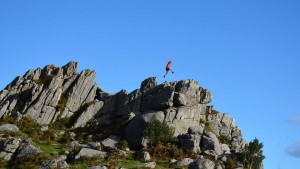Run of the Month – Dartmoor

Flying over Greator Rocks, Dartmoor
Dartmoor National Park covers some 954 square kilometres of moorland, stretching across southern Devon. From luscious leafy wooded valleys cut through by gushing streams to the wild, open moor punctuated by iconic, craggy granite tors, created 280 million years ago, there’s a huge variety of landscape to explore. The highest point on the moor is High Willhays which, at 621 metres, (prominence 537 metres) is classified as a Marilyn.
We’ve recently spent a few weeks here, running, walking, taking photos and generally getting to know the area really well. Other than when researching the routes here for the book, much of our previous Dartmoor running experience had been during the Dartmoor Mountain Marathon and the OMM’s visit to the area in 2010. Taking in some of the southern side of the moor, where much of the running is over rough, grassy, boggy terrain, tricky to navigate and time and energy-consuming, my memories of the place were of a long, hard slog followed by a disappointing injury! Much of the area, however, is wonderful to run, with many fine trails covering exciting and ever-changing terrain.
Here are some of our favourite spots for a great Wild Run, with full route directions for the Templer Way here:
- The granite tramway that used to carry massive loads of stone from the quarry at Haytor down to the sea at Teignmouth is now a waymarked trail, the Templer Way, a fun and varied route for a longer run.
- The moorland wilderness around Princetown makes for a peaceful, gentler outing, with far-reaching views across the bleak open moor.
- The woodland and Nature Reserves on the eastern edge of the moor create some beautiful, tranquil routes, winding through ancient trees and jumping babbling brooks.
To top off a wonderful Dartmoor run there are some great local cafes, perfect for a post-run cream tea. Try the Fox Tor at Princetown, Ullacombe Farm or the National Trust’s Parke.
